Did Karl Kopp Let Historic Building Rot?
Unique 1871 building on river was “irreplaceable.” Bauman blames Kopp for its destruction.
In 1984 restaurateur Karl Kopp, best known for his Kopp’s custard stands, bought the building on 100 E. Seeboth St. next to the Water St. bridge on the Milwaukee River. At the time, the area was in decline: this was well before the revival of the nearby Third Ward and the explosion in downtown residential projects. For two decades the building was underused, mostly for storage.
But by the early 2000s, the redevelopment of the Milwaukee River had turned this location into a potential gold mine, as condo and apartment developments sprang up along the river, many of which rehabbed classic old buildings. The building Kopp owned was now a fantastic location for a residential project. In 2003, Kopp and a partner developer announced plans to raze the building and build a $20 million project with eight condos and some commercial space, but city officials came forward and designated the property, formally known as the J.L. Burnham Building, a historic structure.
The Historic Designation Study Report that was done calls the Burnham Building “Milwaukee’s best-preserved example of an early Italianate style commercial building. Its remarkable masonry work is a testament to its brickmaker owner and the tradesmen who built it and displays exceptionally fine detail in its pilasters, corbelling and cornice.The pressed cream brick was an expensive material in its day… In the hands of master craftsmen here, the cream brick achieved a plasticity that almost contradicts the hard-edged material. The round arches, arcuated frieze, panel effects in the pediment and delicate rondels appear to have been carved from stone rather than built of brick. Such details were difficult to achieve in their day and would be so today.”
The building, the report went on, is “also remarkable as one of only three known surviving Milwaukee examples of the arcaded storefront…Although Italianate commercial buildings survive in limited numbers in Milwaukee, there are no other examples of the early Italianate type that is represented by the J.L. Burnham Building and few that have remained as intact.”
Adding to the building’s pedigree was the surrounding neighborhood, which was the original commercial district of Walker’s Point; because of its architectural significance, the area was listed in the National Register of Historic Places on November 30, 1987.
Kopp might have changed course and considered a project to renovate the 11,430 square foot, two-story building. But instead he dropped his plan and let the building sit.
In 2007 the building was referred to the city Department of Neighborhood Services, says Ron Roberts, the department’s commercial code enforcement manager. “The floors were collapsing,” he notes. “There were several areas of the building where interior floor structures had collapsed. I was surprised by the deterioration that had already occurred.”
What caused the deterioration? A leaky roof, Roberts says. “The water infiltration served to accelerate the deterioration.” Roberts believes the roof had been leaking for years, probably before Kopp had announced plans to erect a new building in 2003.
Had this been an average building, Roberts says, the city would have condemned it. But because of its historic and architectural significance, the raze order was downgraded to a stabilization order, in essence putting the owner on notice it needed to be fixed.
Precisely what exploration was done by Kopp is unclear. In the meantime the roof kept leaking.
In the fall of 2013, Kopp submitted plans to the city’s Historic Preservation Commission to renovate the building and create a pizza restaurant, which would have been a departure from any previous places he owned, though the historic building would have offered the sort of ambiance found at Kopp’s chic Elsa’s restaurant.
Because Kopp was applying for historic tax credits, his plans had to undergo revisions required by the state Historic Preservation Office and the National Park Service. Meanwhile the roof kept leaking.
In March of 2015, the city approved his plans to demolish the interior, which included removing the roof. Did Kopp do anything to protect the interior from the rain or snow that would be falling into the building?
Apparently not. Onmilwaukee.com did a story saluting Kopp for a renovation that “blows the roof off” the building. The photos echo the headline about a building with no roof.
Eight months late, on November 9, the city issued a condemnation order on the building. The order came after city inspectors verified the conclusions of Kopp’s engineer that the building was unstable, with its interior walls at the point of collapse. By then, Roberts says, replacing the building would cost “millions of dollars.”
Kopp, who rarely talks to the press, made an exception in this case and did a “brief interview” with the Milwaukee Journal Sentinel, saying he had spent nearly $750,000 on preliminary efforts toward restoring the structure. “And then we got the news that the building would not withstand that type of renovation,” he said. “…I’m a little depressed. ‘Little’ is being kind.”
It could hardly have been a surprise that the building’s interior was falling apart. It had been falling apart since at least 2007 and probably for years before that. Had it been a normal building, the city would have razed it eight years earlier.
As for what he would do now, Kopp said he might revive the idea to build a new residential and commercial building, the 2003 project thwarted by the city’s historic designation.
Downtown alderman Bob Bauman believes Kopp’s decision to open the roof destroyed the building. “He’s been pretty resistant to the historic process from the beginning. The roof was torn off, so much so that wood was exposed and it deteriorated.”
But Ald. Jose Perez, in whose district the building is located, says he thought Kopp was genuine in his efforts to save the historic structure. “I would have thought it was moving forward.”
Perez notes that when Kopp first announced the plan he had the potential to get a 40 percent historic tax credit from state and federal government, but the state announced a cutback in the credits in February 2015.
But Kopp made it clear he was proceeding after this happened and was soon removing the roof. By the time the building had completely deteriorated, even a 40 percent tax credit wouldn’t have made the building’s renovation feasible.
In retrospect, it’s clear the building had been deteriorating for a long time. Only Kopp knows when the water infiltration began, but we do know he wanted to tear it down in 2003. Perhaps it never was feasible to save. Certainly by 2007 the building was already in terrible shape and would have been in much worse shape by the time the restaurant project was approved.
Yet Kopp hired an architect and claims he spent $750,000 on the project. Was it just a ruse to put off any criticism from the historic preservation community? “It didn’t seem like a charade,” Perez says.
Bauman laments the loss of a “prominent” historic building and “its heritage, its unique identity. If you follow Kopp’s lead, you start to lose all that, what made this city unique.”
Bauman says he cannot recall a case where an owner of a historic building let it fall apart, “at least not to the point where they could maneuver themselves into a raze order.”
If so, this provides a template for other owners of historic buildings that prefer not to save them. Ultimately, there may be little the city can do to prevent this.
Demolition of the J.L. Burnham Building
If you think stories like this are important, become a member of Urban Milwaukee and help support real, independent journalism. Plus you get some cool added benefits.
Political Contributions Tracker
Displaying political contributions between people mentioned in this story. Learn more.
- October 11, 2019 - Robert Bauman received $100 from Karl Kopp
- December 12, 2018 - José G. Pérez received $100 from Karl Kopp
- December 14, 2016 - José G. Pérez received $250 from Karl Kopp
- November 13, 2014 - José G. Pérez received $250 from Karl Kopp
- September 4, 2014 - Robert Bauman received $100 from Karl Kopp
Murphy's Law
-
National Media Discovers Mayor Johnson
 Jul 16th, 2024 by Bruce Murphy
Jul 16th, 2024 by Bruce Murphy
-
Milwaukee Arts Groups in Big Trouble
 Jul 10th, 2024 by Bruce Murphy
Jul 10th, 2024 by Bruce Murphy
-
The Plague of Rising Health Care Costs
 Jul 8th, 2024 by Bruce Murphy
Jul 8th, 2024 by Bruce Murphy


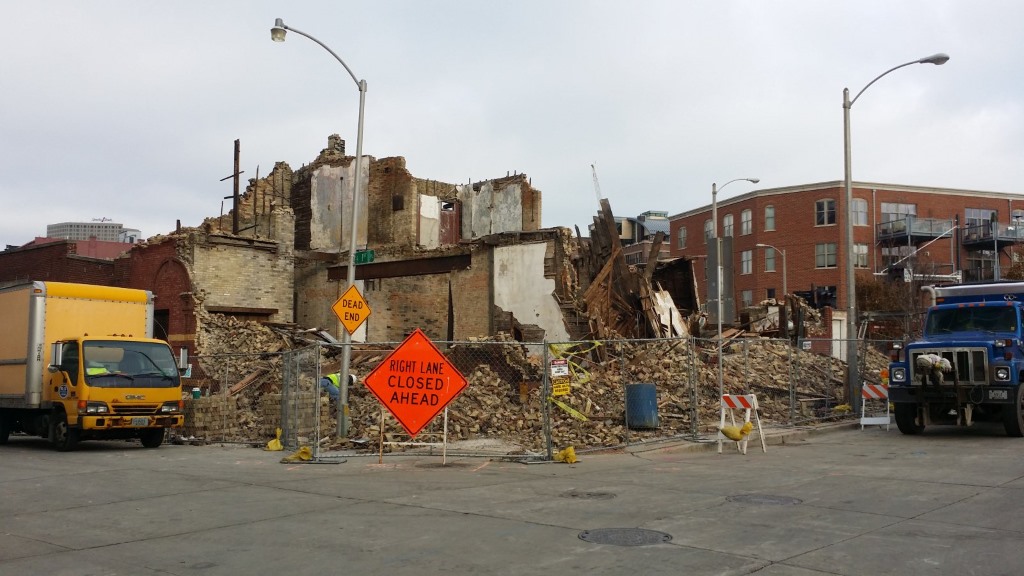
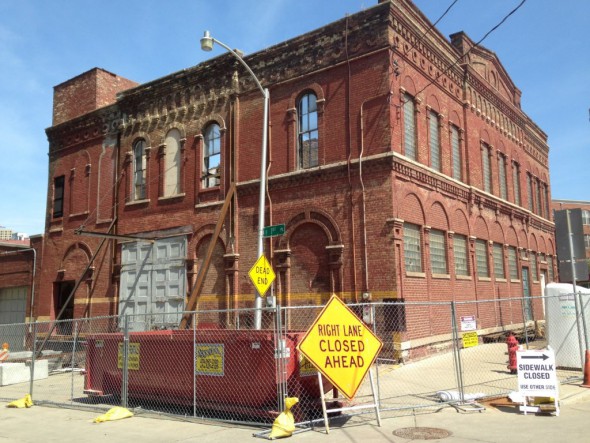
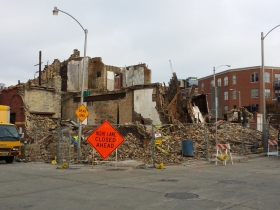
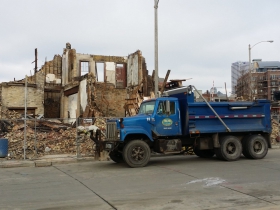
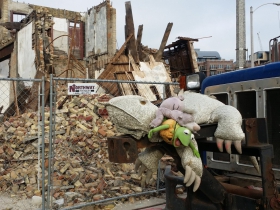
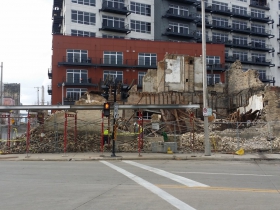
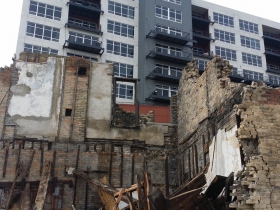
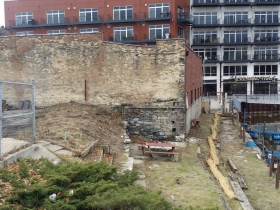



















This truly is a tragedy many years in the making. And it is a tragedy that caused some memorable collateral damage along the way. The 2004 plan to redevelop the building briefly but revealingly pitted local architecture buffs and preservationists against one another. For it appeared that the Burnham building, a rundown, unassuming “eyesore” was standing in the way of an exciting new development. Building owner Karl Kopp and his development partner, Doug Weas were proposing for this site a building designed by the celebrated New York architects Tod Williams and Billie Tsien, “Tod and Billie” as they are known, had recently completed the American Folk Art Museum in NYC, a project that made them the toast of Manhattan and darlings in the world of architecture. Those who sought to preserve the Burnham building were said to be standing in the way of another Calatrava-like landmark in the making.
Whitney Gould, the Journal Sentinel’s revered architecture critic (and one time Madison Landmarks Commissioner) made the case for demolition when, in January 2004, she wrote a column with this lede: “Torn between preserving the city’s past and looking toward its future: …to what extent will inventing a city for the 21st century be hobbled by our warm and fuzzy feelings for the 19th?” (The column, unfortunately is no longer available on-line).
Now the story, like the little building, comes to a rotten end. But not without a bitter and ironic twist.
As it happens, the American Folk Art Museum in NYC, whose building put Tod and Billie on the map, nearly went broke in part due to the expense of the building itself. The museum was forced to move and the building was sold to its next door neighbor, the Museum of Modern Art. It was demolished in earlier this year.
Milwaukee’s system for protecting historic buildings has clearly failed. This is a textbook example of “demolition by neglect,” and the City of Milwaukee is complicit. What kind of historic preservation system allows uncooperative building owners the option of doing nothing, letting Mother Nature conduct the demolition they are legally prohibited from performing themselves?
After so much neglect, the building was indeed in poor shape. It doesn’t take a great imagination, however, to picture how cool it would have looked if restored. According to the City’s experts, restoration would have been expensive (read: lots of local construction jobs), but not unfeasible. Since this had been deemed a culturally important public asset, financial assistance toward restoration was available, via tax credits. Historic buildings are so integral to what makes Milwaukee Milwaukee, and not some generic any-place. We are foolish to sacrifice these irreplaceable assets, and posterity will not judge us kindly for such missteps.
We’re lucky we have advocates for preservation but it often takes a lot of commitment (passion even), vision, and creative effort and financing to make it happen. But averting deterioration is also essential.
I wonder if they made an effort to recycle the building materials, which also have value.
In answer to the title question-
yes he did. And got away with it.
Sorry – but this article seems entirely speculative. What evidence do you have that Kopp just let the building rot? Do you have evidence that he didn’t spend the $750,000? If so, then maybe you have a point…but if he did spend it, it hardly seems likely he’d just piss away 3/4 million just as cover…when if the building was past rehab, a study probably costing less could have established that.
Whether he neglected the building intentionally or not, we as a community need to find better safeguards from letting this happen to other buildings. the city can issue a raze order and have a contractor come in and tear it down so why can’t we ask a contractor to make the building water tight and add it to the property owners tax bill?
I was told by a developer thirty years ago, that unless someone has meticulously maintained a vintage building, it was too costly to rehab, prohibitively costly. What he said was: “…you could tear it down and build something that looks exactly like it, for less money.”
I think some points should be made for Mr. Kopp. He purchased an old rundown building in 1984, used it 19 years for storage and presumably paid property taxes on it. The building was not “landmarked” by the city when he bought it, and he had every right to rely on his ability to manage it as he saw fit within existing zoning ordinances. In 2003, with the neighborhood gentrifying, he saw an opportunity to develop the property and make a tidy profit. I didn’t think that was illegal or unpatriotic or evil. According to a previous poster here, Kopp hired good architects and proposed an attractive apartment building, not a shoddy inferior get rich quick box of a building. Even Whitney Gould, a serious preservation advocate with an influential newspaper column, supported his plan.
At that point the righteous preservationists swoop in to landmark his building and he is forced to abandon HIS preferred use of his property. Now the preservationists want to say what he should have done and what the city should have done to make him do what they think he should have done – all of which involve spending HIS money to do what THEY think he should have done to preserve a property he owned for 19 years as a storage facility without a peep from anyone.
I haven’t a clue about the whether he was or was not dealing in good faith by the time 2013 rolled around – and neither do most of the people opining the issue. I do know the bullying tactics of the HPC and the self appointed guardians of the city managed to stop a property from being developed for 12 years and providing attractive housing and enhanced property taxes.
I am not saying all historic preservationists are always wrong – far from it. But this penchant for landmarking buildings AFTER a longtime owner seeks to develop one can be wielded unfairly and end up with the tqxpyers and the preservationists losing more than they gained. As for Mr. Kopp, I know he is a rich guy and he will survive, and maybe he did “play” the city and the HPC. But I think he has some good arguments for his position.
There are many great comments. There are many buildings that result in a demolition by neglect. It takes a special owner with knowledge and dedication to preserve a vintage building. Anyone that owns an old home or car knows this. And many arguments for just letting it be demolished instead of restoration.
A very recent case in point is the Milwaukee City Hall. Millions spent to preserve it and fortify sinking foundations and falling tiles. Then the wrong caulk that was specified causes millions more in repairs that were already done. Taxpayers supported this one and we could discuss endlessly the pros and cons.
Lucy Cooper’s points are all well-taken. She describes accurately the conflict between our system of property rights and the legitimate urge of a culture to preserve its artifacts.
In my earlier comments I cited Whitney Gould’s column to highlight just how hard this stuff is. I’m sure most observers overlooked the significance of this particular little gem. I’m almost positive Karl Kopp had the best of intentions when he proposed his Tod & Billie project.
The fact remains that this is the kind of tragic waste that happens in every place that is ambivalent about its past. There is a saying that says to invest in real estate because “they’re not making any more.” The same can be said of the things bequeathed to us from the past.
I’m with Lucy Cooper on this one. It’s pretty dirty that someone can take a dilapidated building that no one wants and then the second they try and do something with it all the North Shore Nancy preservationists are suddenly interested in having their say. Where are all these preservationists when the building is falling apart or possibly near foreclosure? They get to put up all kinds of roadblocks and added expenses for the owner – but they don’t have to pony up a dime.
The City’s HPC should do a survey FIRST and then designate those buildings it feels are “historic.” The Common Council can then pass legislation that requires a new buyer to be informed that there are historic preservation requirements on the building. This would enable buyers who do not wish to comply with HPC standards to avoid buying such buildings. But this attacking of owners after they’ve bought a random, undesignated building and then foisting extra costs on them is just not right.
Bill and Lucy make very good points.
I would take Carl Kopps at his word. Look at his other places in Milwaukee, the custard stands and Elsa’s. Very classy in the best possible meaning of term. Elsa’s started out when everyone thought downtown was dead, and decades later retains its vitality like no other establishment in Milwaukee, in part because of Kopps attention to architectural detail and quality.
Preservationist’s in Milwaukee should find a way to allow people like Karl Kopps to make buildings today that will become historic in the future.
“I would take Carl Kopps at his word. ” Really? wow
I was in that building maybe 30 years ago. It was then an antique shop. I think it was owned by Dusty who also rehabbed the building and bar that is now Shaker’s Cigar Bar. There was no water damage then, but much can change in 30 years. The exterior was beautiful and it is a shame it was leveled.
I have been past the Burnham building many times throughout the past Summer- while you couldn’t see much going on from the street vantage point, from the river you could see engineers and construction workers crawling all over the building most of the summer. Having a construction background, I can attest at least $750K was spent judging from the amount and time workers were on site.
It is sad to lose a historic building, but I believe Karl Kopp did his level best to revitalize and restore the building to usable standards. I don’t believe Mr. Kopp would have burnt $750K as a ruse to demolish the building, no savvy businessman would…
I am looking forward now to what may be created on this prominent Milwaukee site.
Attention developers: preserve at least a portion of a building! We have done this before in Milwaukee, although this is rare. Off 3rd and Wells on the northwest corner of the Century Building remains a wall from the Grasller & Gezelschap lighting and plumbing fixtures store. Most noteworthy is the atlas sculpture. Some people may say it means little to most people, but I disagree. The charm and wonder of living in a city (with “old buildings”) is that one can live and work in the foundation of our culture and history.
If Kopp proceeds with a residential tower, I would imagine that a prospective resident of the Fifth Ward would have admired a portion of the former building still existing. It goes with that whole “story of the building” tag that you hear on HGTV House Hunters when a couple looks for an apartment in the city. Of course, they want the “modern” amenities, but they also want the “historic, vintage” charm. Unlike the zealous demolition crews in Milwaukee, Seattle has several examples of building new, high-rise development and preserving historic structures. The New Allen Institute Building and Cristalla Building are two striking examples.
I second Ben’s suggestion. Preservation does not have to be all or nothing. It takes effort, commitment and creativity to seek innovative alternatives. But it does pay off in retaining distinctive character and buildings and neighborhoods that attract people. Authenticity generates economic impact and there’s plenty of proof in Milwaukee.
The Brewery is a prime example. Original plans for Pabst City called for razing 20 of the 28 buildings. Some went down, but many more have been saved. Zilber has done the right things to create an appealing and sustainable neighborhood
Sadly, we lost two stalwart preservationists within the last two years: Paul Jakubovich in the city’s preservation office and Donna Schlieman, a volunteer community advocate. Thankfully, there are still many pushing preservation and the National Historic Trust’s Main Streets USA will be hosting their conference in Milwaukee in May. Let’s hope it inspires even more passion for preservation.
As we speak, state legislators are trying–again–to cut off historic preservation funding.